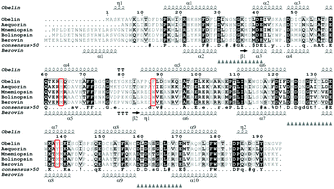Mnemiopsin is a Ca2+-binding photoprotein from Mnemiopsis leidyi that emits a flash of blue light upon reacting with coelenterazine and Ca2+. The light emission is a result of an intramolecular oxidation reaction. Similar to the other Ca2+-binding photoproteins, mnemiopsin is composed of apophotoprotein (206 amino acid residues), the imidazopyrazine chromophore, coelenterazine, and molecular oxygen. The biochemical properties of this photoprotein have been recently characterized but so far there has been no individual study on the role of critical residues. In this study, we introduced some mutations in the mnemiopsin structure for investigation of the roles of some critical residues in the substrate binding cavity, and neighboring residues in the mechanism of the reaction and the bioluminescence properties of the photoprotein. Mutants of mnemiopsin were produced by substitution of residues M77, W101 and M151. Three mutants (W101F, W101Y and M151Y mutants) had significantly reduced luminescence activity and altered bioluminescent properties (such as decay rate, Ca2+ sensitivity, etc.), whereas the fourth (M77H mutant) lost its luminescence activity completely. Our experimental and theoretical studies suggest that residue M77 probably has structural importance and participates in stabilization of active site residues, whereas residue M151 is one of the critical mechanistic residues in ctenophore photoproteins.

You have access to this article
 Please wait while we load your content...
Something went wrong. Try again?
Please wait while we load your content...
Something went wrong. Try again?


 Please wait while we load your content...
Please wait while we load your content...